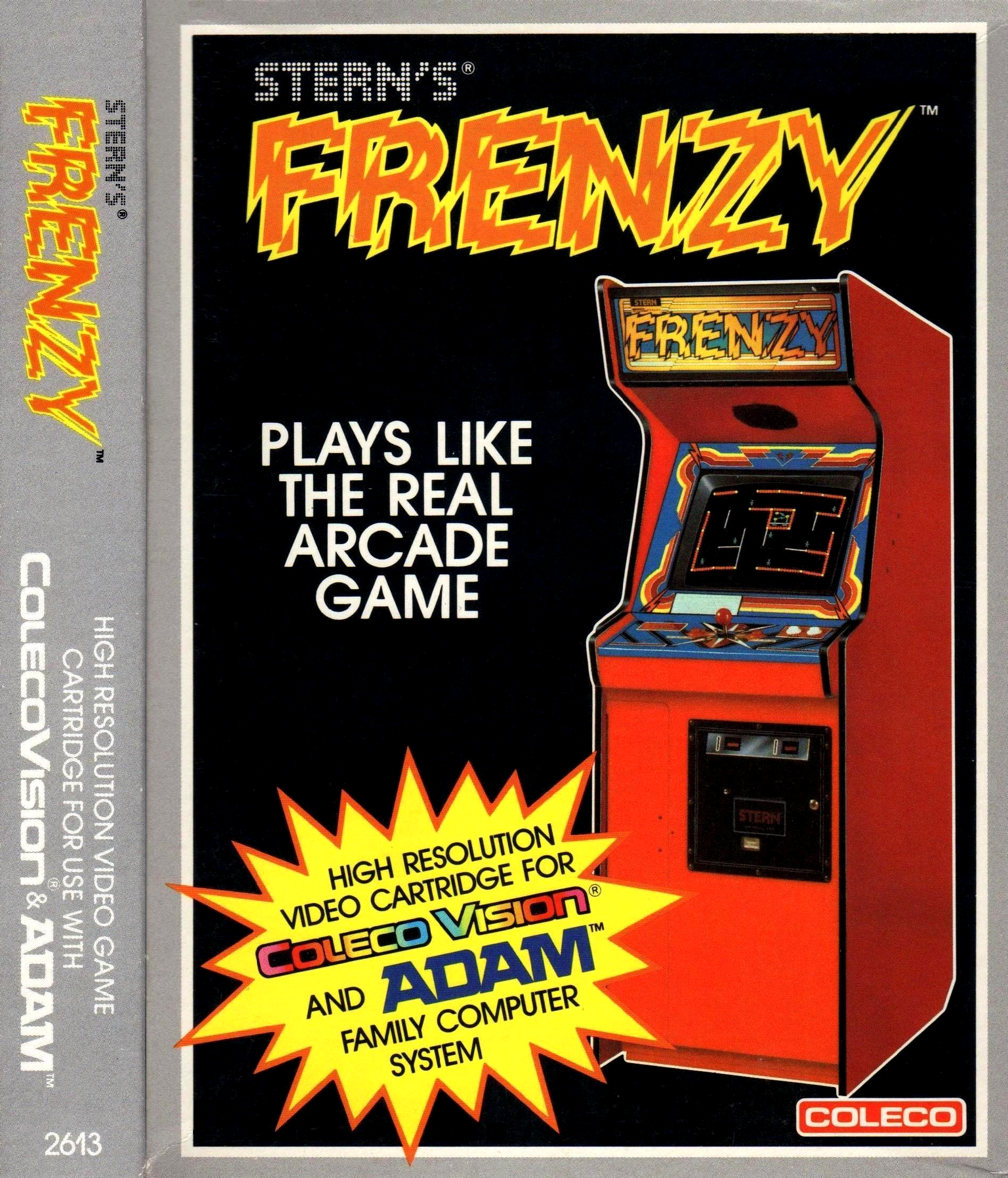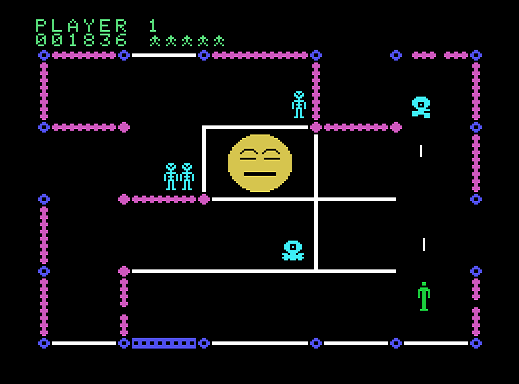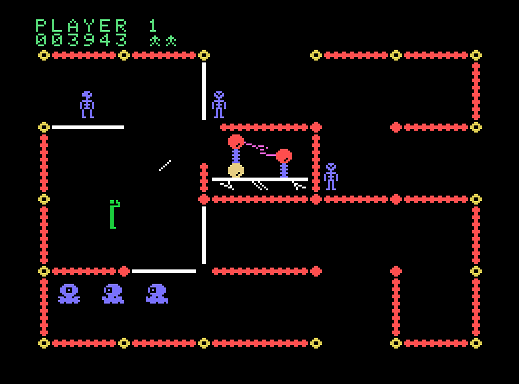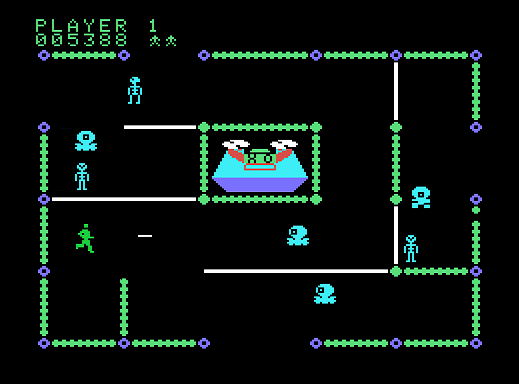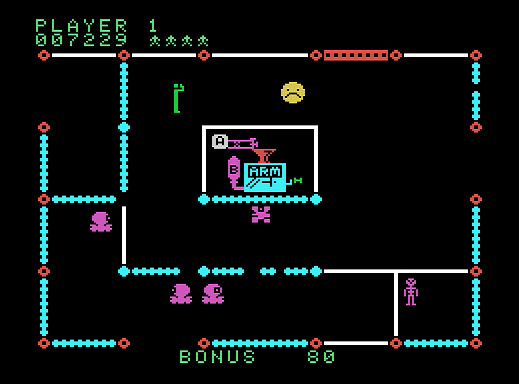FRENZY
A ColecoVision adaptation that beats the arcade original
When Alan McNeil was asked to follow up Berzerk, the vastly influential, late-1980 coin-op whose conception and code had mostly been his own (a dream had inspired him), he resolved to cook up more than a quick-buck rehash, regardless of what Stern Electronics of Chicago might have intended. He got cracking on an even better game than the first -- in terms of longevity, strategic interest and ideal extras, if not ease.
Frenzy's brilliance isn't surprising if you're aware of McNeil's prior experience with superb sequels. Before he worked at Stern, or rather the Stern subsidiary Universal Research Laboratories, he was one of the Dave Nutting Associates, helping to create arcade games (and modify licensed works as necessary) for Midway. 1976's Gun Fight, the American version of Japan's Western Gun -- a Taito game designed by future Space Invaders mastermind Toshihiro Nishikado -- had been adapted by Nutting's Tom McHugh to incorporate one of the first microprocessors in arcade history. About a year later, McNeil revised Gunman, Taito's sequel to Western Gun, for release by Midway as Boot Hill.
He was also chiefly responsible for the '78 Nutting / Midway game Seawolf II. He'd plainly had plenty of predecessor-pounding practice. (I miss Roman numerals. They're super-cool. Aside from that, the prevailing use of simple digits in recent years is one of many grimy guises of the Great Dumbing-Down.)
Frenzy, released in May of '82, requires the same intense focus and peripheral watchfulness as its forerunner, and the violently visceral enjoyment of playing the only character with free will in a fast hide-and-shoot-out isn't diluted; but clever enhancements of the original elements make it more enduringly interesting. They fit so well that the straightforward game-play that makes the precursor work isn't complicated away. To be honest, the Humanoid's new immunity from wall electrocution would have been enough for me. Maybe he's finally smartened up and brought along a pair of protective gloves.
The game runs on the same two-and-a-half-megahertz Zilog Z80 microprocessor as Berzerk, but it outshines that simple-maze match with two types of robot instead of one; awesomely random screen layouts that more closely resemble actual mazes; shot-deflecting walls; destructible walls, which allow you to create your own maze exits when they serve as borders; a machine that stands near the center of every fourth maze, starting with the fifth (provided that you don't get killed and sent backward), and which your firepower game-changingly disables; and a vulnerable but perpetually reincarnating Evil Otto, that formerly invincible, unsettlingly merry, dismembered head that hops into the current maze if you're taking too long to leave it (by his watch, the arrogant bastard. Where does he keep it, anyway?).
There's a handful of home conversions that I prefer to their arcade counterparts. Even the Atari 2600 VCS has a few. Frenzy is one of two such ColeConversions (Pepper II is the other). This 24-kilobyte jewel was developed for Coleco Industries by an Austin, Texas firm called Davis & Nussrallah & Associates. It was programmed by one or more regrettably unknown whizzes and released a year after its arcade antecedent.
It's also the only official console realization. Coleco did issue a computer version -- for the Sinclair ZX Spectrum -- and even though I've never played it, I'll risk the presumption that it's not as good, based on my encounters with other "Speccy" games. That budget computer certainly epitomizes the saying, "You had to be there," i.e. in England without a Commodore 64.
You can still find a normal, imperishable, non-deflective, seen-one-seem-'em wall, but only alongside your Humanoid when he's entered a new maze. It actually looks like a door that's been riveted shut. If it is, then it's surely meant to keep him from running right back through it as he recoils from the seemingly overwhelming amount of enemies around him.
This leads me to the first source of ColecoVision Frenzy's superiority over the original: You can select a game variation that starts things off much easier and provides a more reasonable difficulty curve as the session progresses. Don't get the wrong idea; it's still difficult enough to warrant a practice game before you truly get down to kicking metal ass. (I don't mean like Iron Maiden. I mean like the fearless, heavy-duty action hero you are.)
As in Berzerk, the first maze always contains unarmed robots. Your Humanoid is no longer killed when he collides with one of these aluminum jerks, so this lone yellow-robot screen is a walk in the park -- well, hedge maze -- that's meant to acquaint you with the game-play. Otto, whose entry point is the same as your own, poses the only danger. Starting with the subsequent, orange robots, you've got to watch your back. And your front. And your sides. Death most frequently occurs when you've overlooked just one possible enemy-fire direction out of eight.
Before you reach any machinery, you'll find an oversized baldy who I call Papa Otto. Notice on the screen above that he is, thankfully, hibernating. Shooting him through the weak corner of his deflective cave achieves nothing but your satisfaction (he must feel it, at least, right?). He smiles in his sleep when your Humanoid dies, and he noticeably suffers a nightmare when the labyrinth is left behind.
He sure wakes up quickly when his springing offspring get killed. He assumes a fearsome, enraged expression, and instead of attacking your Humanoid himself, he spinelessly unleashes four of the genetically defective, psychotic progeny he's been keeping in his basement maze. Their speed leaves you with no chance, unless an exit's close at hand when you decide to commit Ottocide.
The first actual device is a nifty configuration of lightning-swapping dynamos, straight out of an old science-fiction movie. Nailing this Power Plant through one of its vulnerable walls freezes the robots. Your own cockiness can thus become your primary rival, as their guns clearly have their own internal power sources. Still, it's fun to run circles around 'em and rub it in: "Aww. You can't move! And I still can! It's one of the advantages of not being a robot, you freaks."
The coin-op's default setting awards an additional Humanoid at every three thousand points. On the ColecoVision, an extra arrives at one thousand, and then at every two thousand thereafter. These diligent warriors can run or fire in any of eight directions, but both actions can't be taken at the same time. This isn't a big deal, as the pause is mercifully brief. Trying to shoot without moving the controller doesn't do a thing, but holding down the button when it applies yields continuous fire. I don't recommend that you exploit this, as a halted Humanoid rapidly becomes an ex-Humanoid.
As in Berzerk (which wasn't made for the ColecoVision, incidentally), the robots can kill each other -- to the benefit of your score -- but now they can kill themselves, too, thanks to their own ricocheted shots. With regard to android suicide and game-play balance, the deflective walls compensate for the missing lethal ones. Frenzy's above-average difficulty relies wholly on the robots' excessive numbers.
If you're as good as I am, you'll eventually reach a maze whose dividers all repel shots, irrespective of texture. These show up in the arcade game as well; it was a sly move on McNeil's part. Once you've exceeded 20,000 points in either version, place yourself on alert for an entirely white maze. To prevent your own character's suicide, resist the habit, developed over the course of the game, of impulsively firing at lumpy walls to wear them away.
Speaking of Humanoid death, the second reason for my partiality toward the home game is that the hero doesn't posthumously regress to an earlier screen. The maze is randomly renovated, but the machine (if present) and robot color remain.
The second device is a giant reel-to-reel tape player, which looks even more like a face in the coin-op game, complete with scientifically unsound tongue. (This represents a recording method that even I'm not familiar with.) The rather disturbing gizmo is evidently the source of the robots' ocular facilities, as its ruin blinds most of them. Not only can they no longer determine your location, but when they walk into walls, they do so with such oblivious vigor that they explode.
Essentially, disabling this contraption, which is actually the Central Computer, is almost always tantamount to detonating a smart bomb; all robots in the vicinity are doomed. So it's the same as when you shoot a huge tape player in real life. One with a tongue, anyway. Your enemies really do appear to go berserk! They're in a frenzy indeed! Okay; I'll stop. At no other time is collision with the various maze dividers hazardous to their artificial health. (By the way, don't feel bad about eliminating so many of these tin scumbags. Robots aren't people.)
One especially tricky, intermittent maze entry entails hastily locating your own character before he's gunned down, as the robots try to disguise themselves by mimicking his shade of green. The best tactic is to fire right away. Two of your projectiles can exist simultaneously, so you'll still be able to waste the nearest robot once you've gotten your bearings. In the arcade, you can alternatively foil the first enemy shot; at home, laser slugs fly right past each other, appearing from your 2-D perspective to be perfectly aligned.
Run perpendicular after launching your Humanoid-finding shot, in case you've just made him fire at a bouncy wall. Of course, if he gets killed, it will be much easier to locate his replacement, who'll blink a few times. I wish the same would happen upon initial entry. Mental note: Wear mixed colors before infiltrating hostile mazes.
When you find your digitized incarnation on the other side of a deflective wall from a throng of enemies, run back and forth and watch them shoot themselves and each other. It's also great when a destructible wall stands between you and a robot convention, and you've got plenty of space to dodge their shots without difficulty as you wipe them out. Things get better still when there's a second vulnerable partition beyond all of that, holding back even more robots. They all line up with you, laboring under the sad illusion that they're going to score.
Simply put, the game's most fun when there's a lot of destruction going on, given that you're on the destroying end. Destruction of imitated life, destruction of property...I can dig it. Go ahead and line up, robots. Be patient, though. I promise: I've got some death for each and every one of you.
The third and final apparatus (prior to your return visits) is the Automated Robot Maker. That's how I interpret the acronym painted on it, anyway. It provides the third reason for my preference for this version of Frenzy: One shot through its single weak wall renders it inoperative, whereas it won't get a scratch in the arcade game. This represents either a bug or a missed opportunity; but on Coleco's console, you can finally stop it from spitting out those extra automatons.
Whether or not you do so, you'll receive the usual maze-departure bonus points if you've blasted enough robots to equal the amount that was present when you entered, in keeping with the coin-op's corresponding screen. You'll know that you've eradicated a sufficient number when the bonus tally appears beneath the maze. You'll also hear a drawn-out sound that resembles the repeated croaks of a frog trapped in a clothing dryer.
It's especially cool to shut down the officially so-named Robot Factory during the incomplete emergence of a new maze-dweller, who thus explodes during birth. (Now, there's a bit of narration that you'll never hear in a nature film.) It's also entertaining to run just far enough to lure a robot out from behind a distant wall. He'll appear for all the world to be saying, "Oh, you can't shoot me from there? Well, let me help you out. Is that better? Wait a second -- what am I YEEEEEAAAAAAARGH!" (in a monotone voice, of course).
Concerning the bouncy kind of wall, you'll often find two that form a straight corridor. This game's upgraded robots happily remain dumb enough, no matter how long you play, to walk right into your line of fire. They might be made of metal, but they're still vegetables. You see where I'm going with this. Unleash a series of diagonal ricochets off the parallel walls to hit distant androids. Each shot will survive several glances. In fact, it will turn traitor when it retraces its route, so avoid firing at a rebounding surface from close by. Such walls are also great for nailing robots from around corners.
Always keep in mind that contact with a robot's brief explosion is fatal to all combatants, including your Humanoid, albeit for much less time than in the arcade game; and that one to four mazes separate those containing the Big, Extra Things (TM) in the home version, depending on the Skill Level that's been selected (out of four, logically enough).
On that subject, Skill Level 1 gives you five Humanoids, the others three. In the interest of thoroughness, I'll point out that the Coleco game's instructions refer to the Humanoid as a Commando. I'm sticking with the arcade terminology; if he really were a Commando, he'd have more than one weapon. He'd also be able to run and fire simultaneously.
One of the many cool things about either version of Frenzy is that you finally get to kill R2-D2 and C-3PO -- again and again and again. The latter is slightly harder to hit along a vertical trajectory, as he's undernourished (in robot terms). Take into account that unlike your arcade adversaries, these don't move faster as you reduce their numbers; only the final robot accelerates. Their collective starting speed depends on the Skill Level. Elements that are retained from the original are the change in communal robot color and the consequent increase in the group's possible on-screen projectiles.
In spite of my extolling, I'll allow that Frenzy is such a distinct game that straight comparisons with Berzerk would be unjust. There is, of course, one enemy whose return bears contemplation. According to Tony Miller, the assistant programmer of both arcade games, Evil Otto was named after Dave Otto, Nutting's head of security, coffee making and toilet-paper refilling. McNeil remembered him for smiling while he scolded and locking the building at noon to inflict lunchtime on everyone.
Something distressing must have happened in the character's life between the two games; he's been renamed Crazy Otto. If you ask me, he already had a few loose screws. How sane can you remain without a body, really?
He'll continue to hurdle walls and inadvertently help you to collect the post-maze bonus for wiping out all robots. Whereas blasting him in the first game has no effect, three shots in this one (or four, at the highest Skill Level) deflate him like a stuck beach ball. He returns immediately and bounds toward you even faster, rather than waiting to speed up until you've destroyed the final robot as in Berzerk. His fourth manifestation is virtually impossible to evade; but be reassured that he can't erase the memory of death from his now tortured past. In any case, it's great to wipe that smirk off his face at last.
When you're feeling especially malevolent and you'd like to annoy him before you kill him, bring your face close to the screen and ridicule him: "Oh, look at the bouncy ball! How cute!" That really bothers him. Or try this: "Your mother's Silly Putty!" There's nothing like making Crazy Otto even crazier before you let all the air out of him.
Thanks to a microchip made by a company called National Speech, the original Berzerk and Frenzy feature synthesized voices that say funny things, such as "Coin detected in pocket!" and "Chicken! Fight like a robot!" in the former, and "Where is the Humanoid?" (when the robots have been robbed of their vision) and the admittedly sensible "A robot is not a chicken!" in the latter.
In the ColecoVision game, the robots are finally silenced. Those players who actually enjoy the heckling can appease themselves by recognizing that like music, storylines and cabinet or packaging illustrations, the voices have nothing to do with the game-play itself, which is all that ever matters. (Speaking of extraneous stuff, the arcade marquee actually attributes the game to Stern / Seeburg. This is explained in the Turtles article.)
The sole Stern-sanctioned home version of Frenzy is executed flawlessly. The animation remains smooth and varied, the mazes spacious but intricate, the sounds explosive but diverse. The graphical interaction, controller responsiveness and collision detection have been fine-tuned to a degree far beyond "Just doin' my job" by the lamentably anonymous programmer(s). What's more, only one firing button is necessary, so Coleco's unwieldy controller can be foregone in favor of a single-button joystick, such as my favorite, the good ol' Atari CX40. Fetch it for me, Otto. Come on. Hop to it.
